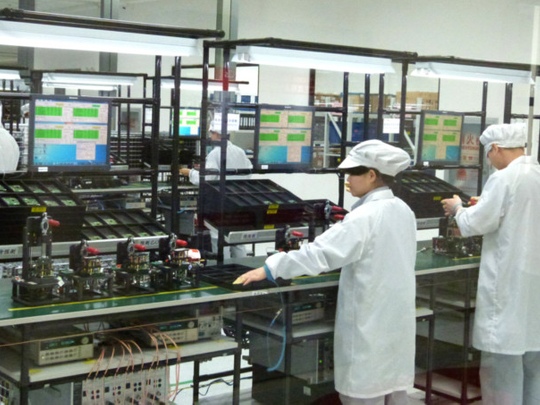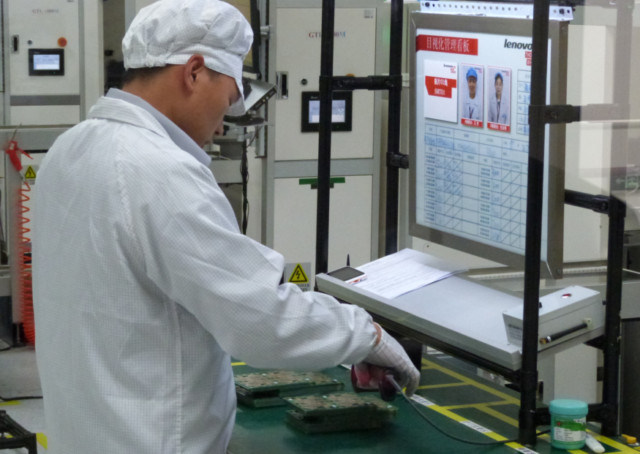
Wuhan, China
In the smartphone world dominated by Apple and Samsung, Lenovo may be a small player now in terms of volume. But that is very likely to change with the opening of the state-of-the-art plant at Wuhan industrial district.
The Chinese manufacturer sold around 50 million units in 2013 compared to Samsung’s 314 million and Apple’s 153.5 million despite having no presence in North America, Western Europe and some parts of the Middle East and Africa. The company’s sole strength lies in emerging markets amid started selling its smartphones in 2010.
That is going to change in the next two to three years’ time, as it is gearing up to shake up the rankings.
Lenovo became the fastest growing major smartphone company in the world last year.
The company took some tech journalists in the Europe, Middle East and Africa to tour their plants in Beijing, where PCs are manufactured, and in Wuhan, where tablets and smartphones are manufactured.
The Wuhan plant, which will be used for research and development, production and sales and service facility, was opened in December 2013 with an investment of around $200 million and with a gross floor area of 200,000 square metres. The total investment overlay is around $800 million for the next five years.
The construction started in December 2012. The Chinese government offers incentives for companies setting up bases in Wuhan.
Before this, Lenovo’s mobile devices were made from its plant in Xiamen, Fujian. With the growth in shipments, the capacity of Xiamen plant cannot meet the demand anymore.
It was my first time getting inside a manufacturing plant and it was worth it.
It was good to know what kind of reliability tests are undergone during mass production and the time required to assemble a smartphone or a tablet.
Lenovo does around 50 tests on mobile devices and assembles a mobile device between seven and nine minutes.
The tests include vibration test for logistics, micro drop test by dropping the mobile device 9,000 times from 1.5 metres high, RF test, electromagnetic test, battery test, salt and mist test, headphone and USB test and quality of touch-screen test.
Despite some labour issues in China, Lenovo pays its 3,000 workers $300 each and dormitory accommodation worth 100 yuan.
The Wuhan facility is expected to create around 10,000 jobs in the coming years.
Labour cost is low compared to more developed eastern China and, no doubt, most of the top manufacturing giants have their base in Wuhan.
Jack Zhu, executive director of manufacturing operations at Lenovo, said the workers work nine hours for five days a week before overtime plus they have two breaks where they can take a quick nap.
He said the semi-automatic plant, which is currently utilising only 50 per cent of the building is capable of producing 100 million of smartphones and tablets per year. The factory is currently producing 30 million a year.
“We have much better facilities than Foxconn, especially recreation facilities, and we take care of our staff well,” Zhu said.
Apple had issues in the West regarding child labour and worker suicides at Foxconn plant.
Leo Curtis, ambassador of Lenovo customer centre at Beijing plant, said that Lenovo employees make higher than average salary rate and the retention rate is high. It is rated as the number one Chinese company for the Chinese people to work at.
“We offer special trainings and Yoga classes to our staff and hold round-table discussions with them. Foxconn does not offer a tablet to its staff but we do. We offered a Yoga tablet to all our employees,” Zhu said in laughter.
The Beijing plant’s innovation centre also gave us the opportunity to understand the philosophy of its ID design, including how the design team puts science, art and humanities into their design and how the merging of East-West culture to create innovative products.
Lenovo, which bucked the trend by assembling its PCs itself without outsourcing it, has adopted the same strategy in the mobile space also.
Curtis said that none of the other laptop manufacturers do not do the same level of tests we do. We test our unit from -40 degrees to +60 degrees as it differs from country to country.
The laptops undergo various tests, similar to mobile devices, before packing.
He said that Lenovo wants to make sure the laptop, before it reaches the hands of the consumers, has to be perfect with no issues. Even the hinges are tested for more than 10,000 times to make sure.
That is why Nasa used Lenovo ThinkPad laptops in space. ThinkPad 750 flew aboard the Space Shuttle during a mission to repair the Hubble Space Telescope on December 2, 1993.
Lenovo has partnered with Taiwan’s Compal to set up a joint plant in Hefei, Anhui, producing desktops and laptops.
The Wuhan facility develops its own motherboard and gets components from other huge list of suppliers. Component supply is not a problem as most of the suppliers are within a reachable length.
Zhu said that one in every 10,000 units undergo vigorous tests during packing.
“The company controls its costs much better than its rivals due to the ability to manage inventory depending on the demand, said Aymar de Lencquesaing, president of EMEA and senior vice-president of Lenovo Group.
The revenue generated from the plant is expected to reach 10 billion yuan by the end of 2014 and touch 50 billion yuan by end of 2018.
Regarding talent pool, Zhu said that Wuhan has no shortage of talent as there are 52 colleagues and universities with 1.2 million colleague students from a population of 10 million.











